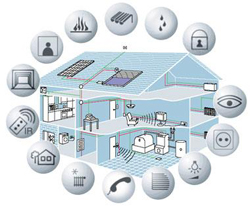Building Management Systems
A Building Management System (BMS) is a computer-based control system installed in buildings that controls and monitors the building’s
mechanical and electrical equipment such as ventilation, lighting, power systems, fire systems, and security systems. A BMS consists of software and hardware;
the software program, usually configured in a hierarchical manner, can be proprietary, using such protocols as C-bus, Profibus, and so on, recently, however,
new vendors are producing BMSs that integrate using Internet protocols and open standards such as DeviceNet, SOAP, XML, BACnet, LonWorks and Modbus.
We undertake commercial, institutional and other various building management systems in Bangalore, Mangalore, Hyderabad and Chennai.
Characteristics
Fire alarms are life-saving devices that provide benefits for occupants. An automatic fire alarm system is designed to detect the unwanted presence of fire or A BMS is most common in a large building. Its core function is to manage the environment within the building and may control temperature, carbon dioxide levels and humidity within a building. As a core function in most BMS systems, it controls heating and cooling, manages the systems that distribute this air throughout the building (for example by operating fans or opening/closing dampers),
and then locally controls the mixture of heating and cooling to achieve the desired room temperature. A secondary function sometimes is to monitor the level of human-generated CO2, mixing in outside air with waste air to increase the amount of oxygen while also minimising heat/cooling losses.
Systems linked to a BMS typically represent 40% of a building’s energy usage; if lighting is included, this number approaches 70%. BMS systems are a critical component to managing energy demand. Improperly configured BMS systems are believed to account for 20% of building energy usage, or approximately 8% of total energy usage in the United States.
As well as controlling the building’s internal environment, BMS systems are sometimes linked to access control (turnstiles and access doors controlling who is allowed access and egress to the building) or other security systems such as closed-circuit television (CCTV) and motion detectors. Fire alarm systems and elevators are also sometimes linked to a BMS,
for example, if a fire is detected then the system could shut off dampers in the ventilation system to stop smoke spreading and send all the elevators to the ground floor and park them to prevent people from using them in the event of a fire.




